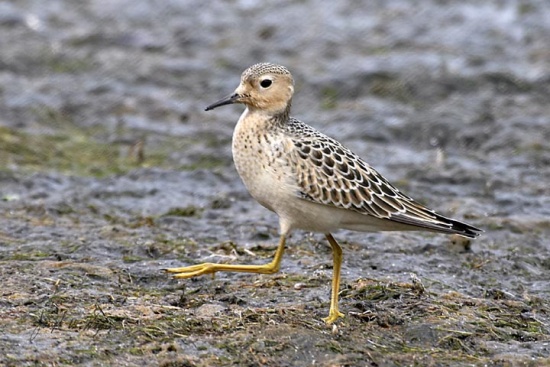Nomdeploom (talk | contribs) |
(Attempt to disguise copied text. References) |
||
| Line 1: | Line 1: | ||
| − | [[Image:Buff-breasted_Sandpiper.jpg|thumb|550px|right|Photo by jvhigbee <br/> | + | [[Image:Buff-breasted_Sandpiper.jpg|thumb|550px|right|Photo by {{user|jvhigbee|jvhigbee}} <br /> Port Townsend, [[Washington]], September 2003]] |
;[[:Category:Tryngites|Tryngites]] subruficollis | ;[[:Category:Tryngites|Tryngites]] subruficollis | ||
| − | |||
==Identification== | ==Identification== | ||
| − | 45cm | + | 45cm |
| − | + | *Buff head, neck and underparts | |
| + | *Scaly brown upperparts | ||
| + | *Black streaked crown | ||
| + | *Cream throat | ||
| + | *Finely spotted on breast sides | ||
| + | *Short, straight bill | ||
| + | *Greenish-yellow legs | ||
==Distribution== | ==Distribution== | ||
| − | '''Breeding''': Tundra of eastern [[Siberia]] to [[Canada]]. <br> | + | '''Breeding''': Tundra of eastern [[Siberia]] to [[Canada]]. <br /> |
'''Non-breeding''': Mainly [[South America]], but known as a vagrant almost worldwide. | '''Non-breeding''': Mainly [[South America]], but known as a vagrant almost worldwide. | ||
==Taxonomy== | ==Taxonomy== | ||
| − | + | This is a [[Dictionary_M-S#M|monotypic]] species<sup>[[#References|[1]]]</sup>. | |
==Habitat== | ==Habitat== | ||
| − | Dry grassy areas. | + | Dry grassy areas, beaches, wetlands and muddy fields. |
==Behaviour== | ==Behaviour== | ||
| − | The female builds a nest on the ground, lined with grass. 3-4 eggs are | + | ====Breeding==== |
| − | + | The female builds a nest on the ground, lined with grass.The 3-4 eggs are incubated by the female for 3 weeks. The chicks are [[Dictionary_M-S#P|precocial]] and leave the nest less than 12 hours after hatching and able to feed themselves. | |
| + | ====Diet==== | ||
The diet includes earthworms, aquatic insects and larvae, and seeds. | The diet includes earthworms, aquatic insects and larvae, and seeds. | ||
| − | |||
==References== | ==References== | ||
| − | ARKive | + | #{{Ref-Clements6thDec09}}#ARKive |
| − | + | {{ref}} | |
==External Links== | ==External Links== | ||
{{GSearch|Tryngites+subruficollis}} | {{GSearch|Tryngites+subruficollis}} | ||
[[Category:Birds]] [[Category:Tryngites]] | [[Category:Birds]] [[Category:Tryngites]] | ||
Revision as of 23:38, 3 September 2010
- Tryngites subruficollis
Identification
45cm
- Buff head, neck and underparts
- Scaly brown upperparts
- Black streaked crown
- Cream throat
- Finely spotted on breast sides
- Short, straight bill
- Greenish-yellow legs
Distribution
Breeding: Tundra of eastern Siberia to Canada.
Non-breeding: Mainly South America, but known as a vagrant almost worldwide.
Taxonomy
This is a monotypic species[1].
Habitat
Dry grassy areas, beaches, wetlands and muddy fields.
Behaviour
Breeding
The female builds a nest on the ground, lined with grass.The 3-4 eggs are incubated by the female for 3 weeks. The chicks are precocial and leave the nest less than 12 hours after hatching and able to feed themselves.
Diet
The diet includes earthworms, aquatic insects and larvae, and seeds.
References
- Clements, JF. 2009. The Clements Checklist of Birds of the World. 6th ed., with updates to December 2009. Ithaca: Cornell Univ. Press. ISBN 978-0801445019.
- ARKive
Recommended Citation
- BirdForum Opus contributors. (2024) Buff-breasted Sandpiper. In: BirdForum, the forum for wild birds and birding. Retrieved 4 May 2024 from https://www.birdforum.net/opus/Buff-breasted_Sandpiper




